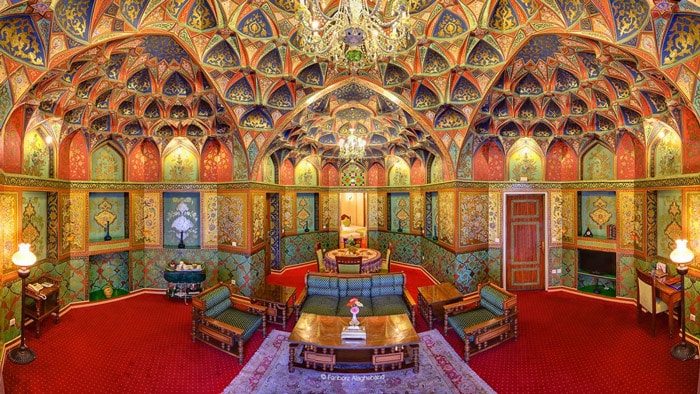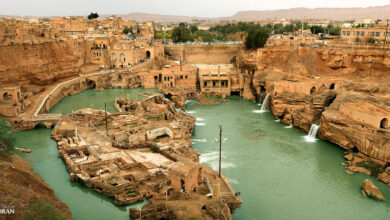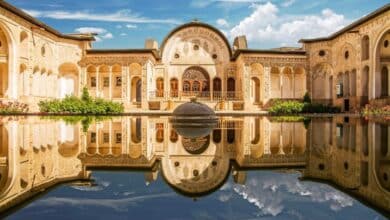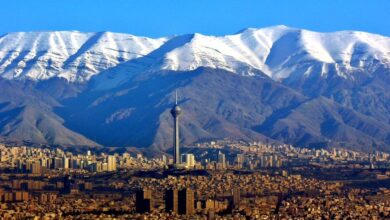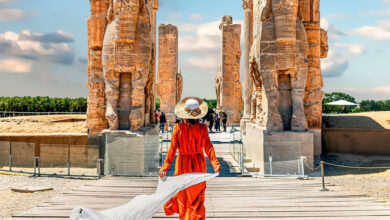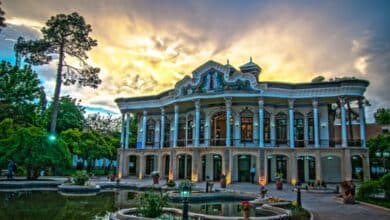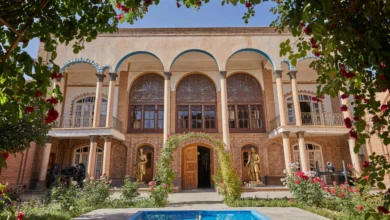Chehel Sotoun Palace: Discover the Palace of Forty Columns
A Symbol of Persian Architecture in Isfahan
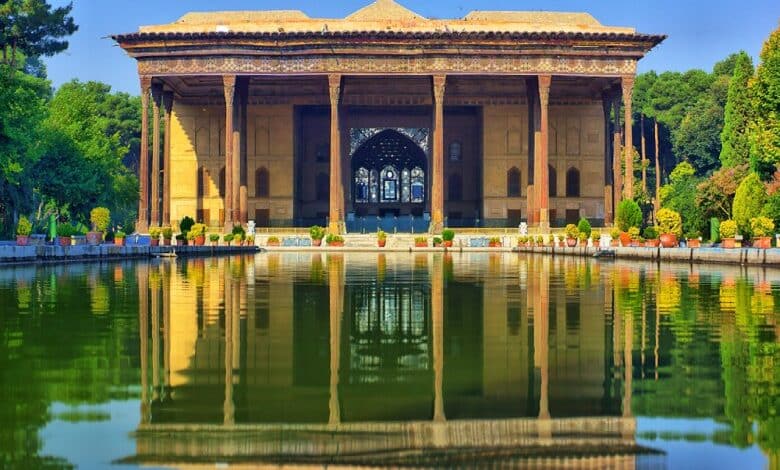
The ancient Chehel Sotoun Palace in Isfahan, Iran, is a striking example of the Safavid era‘s clever architecture and artistic skill. This beautiful building was built in the middle of the 17th century during the reign of Shah Abbas II. It is famous for its name, which means “Forty Columns. ” The name comes from how its twenty thin wooden columns look when reflected in the palace’s nearby water feature, giving the impression of forty.
The palace is set in a beautifully landscaped park and decorated with detailed frescoes, tiles, and large murals that vividly show historical events and Persian court life. This makes the palace a vital place to visit if you want to learn about Persian culture and history. Chehel Sotoun Palace is now a UNESCO World Heritage site, showing how beautiful Persian architecture can be and how rich Iran’s culture and history are.
Contents
A Quick Look at the History of Isfahan’s Chehel Sotoon Palace
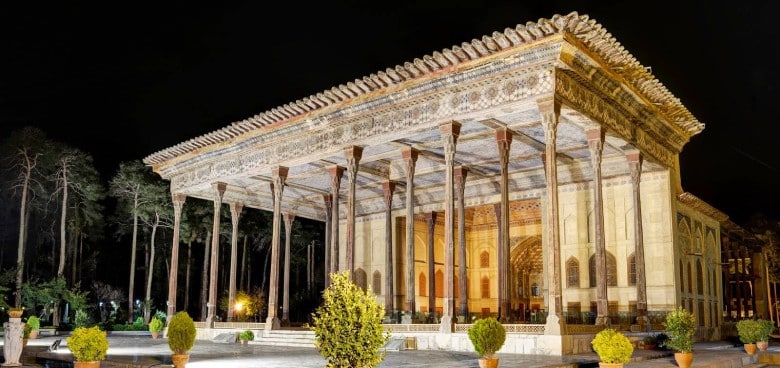
The first king of the Safavid Empire was Shah Abbas I, also known as Shah Abbas the Great. He is the first person in history to give the palace its name. At the end of the 1600s, the king of a new dynasty decided to move the capital of his kingdom to Isfahan. This was the second time in Persia’s history that the capital had been moved, changing the city’s history and appearance. This was the start of Isfahan’s golden age.
Shah Abbas I started many significant building projects to bring the old city up to date. One of the most important projects was building Chahar Bagh Avenue, a big street with many parks. This park was the most important because it linked Chahar Bagh to Naqsh-e Jahan Square. It is now called Chehel Sotoun Palace.
This garden was perfect for the king because it was close to Ali Qapu Palace, where the Safavid court worked. The king then ordered the building of a pavilion house there. People say the mansion wasn’t very fancy—nothing like the beautiful building we see today. But it was still used to host gatherings and small celebrations for foreign officials and important guests. Records from 1614 show that King Shah Abbas I marked the Persian New Year, Nowruz, in that household.
So, this building was the first part of Chehel Sotoun Palace. Shah Abbas II, the seventh king of the Safavid Dynasty, chose to turn this house into a palace around the middle of the 17th century. He then made it bigger by adding more rooms and chambers. Most of the fancy decorations, like the wooden columns, mirrors, and painted ceilings, were added by Shah Abbas II. Like his ancestor, he used the palace to host diplomats and other important guests.
Structure of Chehel Sotoun Palace
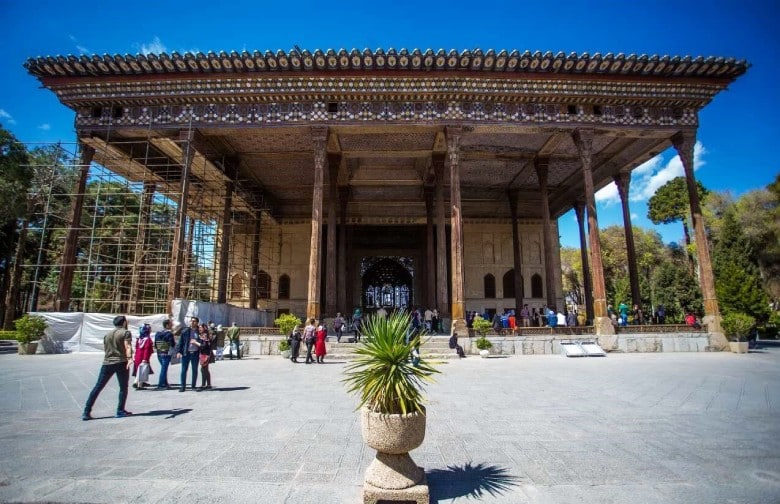
Chehel Sotoun Palace is built on a 67,000-square-meter piece of land. It was designed with ideas from buildings in China, Iran, and Europe. Walking into the house, you’ll see a balcony with 20 columns of cypress wood. But since it’s called Chehel Sotoun, there must be 40 columns. The water in the pool reflects the 20 actual columns, making it look like there are 40 of them. It’s important to remember that the number 40 in Iran stands for variety in general.
As a result, we can assume that a lot of thought went into building such a beautiful structure. Frécheworks and cachet themes are also used to decorate all doors and windows. Several ornate drawings are also on the walls of the palace’s main hall. Each one refers to an important event that happened at a specific time. Each of these parts shows how skilled Iranian masters and builders are.
Why Is It Called Chehel Sotoun?
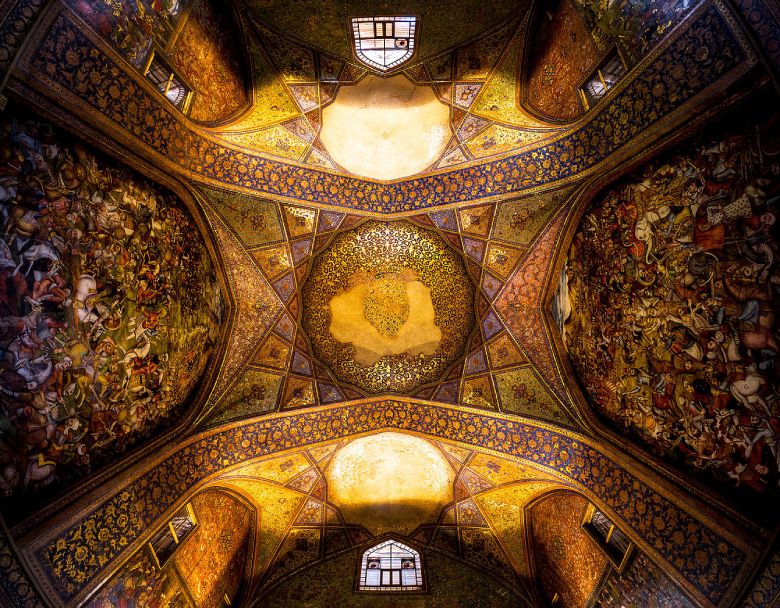
Behind the mysterious sound of the name “Chehel Sotoun” lies an exciting story. It is said that “Chehel” means “forty” in Persian, and the name comes from how the house is built.
Twenty thin wooden columns stand in front of the palace’s main pavilion. If you look at these columns in the water of the center fountain, you can see an illusion: they look like they’re growing into forty columns. This optical trick adds a magical touch to the palace’s beauty by subtlely playing with the viewer’s perception.
The number forty has cultural meanings beyond this fantastic piece of architecture. When Chehel Sotoun was built, forty stood for grandeur, wealth, and greatness. It wasn’t just a number; it had a deeper meaning that showed how grand and enormous the building was.
Book Iran Flights
Buy Iran flight tickets at the lowest price
Explore Iran’s culture and history with affordable and reliable flight tickets.
Last Word
Isfahan has a lot of culture and historical history thanks to the Chehel Sotoun Palace. It is a must-see landmark because of its unique design, the peaceful beauty of its gardens, and the wealth of history that can be found inside its walls. This house shows off the Safavid era‘s sophisticated art and building skills and connects the past to the present. You are encouraged to think about the events and stories that shaped this beautiful site as you walk through its halls. Each visit is like going through Iran’s long and exciting history.
FAQs
Where to Eat near Chehel Sotoun Palace?
After seeing this beautiful palace, several places are likely nearby to eat something delicious. So, if you’re in Isfahan, try these top places for delicious Persian food. The following restaurants serve food: Shahrzad Restaurant, Azam Beryani Restaurant, Grandma’s Table Restaurant, Adak Fast Food Restaurant, Venice Restaurant, Malek Soltan Jarchibashi Restaurant, Nobahar Restaurant, Bakhtiari Restaurant, Hakim Bashi Persian Restaurant, and Saraye Simorgh Restaurant.
Where to Stay Near Chehel Sotoun Palace?
Several hotels are close to Chehel Sotoun Palace for guests worried about mileage. Some of these hotels are the Piroozi Hotel (4 stars), the Safavi Hotel (3 stars), the Tourist Hotel (3 stars), and the Partikan Hotel (1 star).Stay at one of these hotels for a few nights in Isfahan for some great experiences.
How Do I Get To Chehel Sotoun Palace?
To find out how to get to Chehel Sotoun Palace, all you have to do is go to Isfahan’s Dolat Gate Square. The public transportation in Isfahan has made your job easy. You can get off at the Imam Hossein metro station or bus stop to get to this beautiful place.
